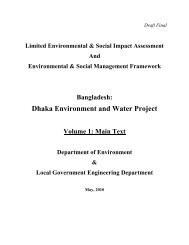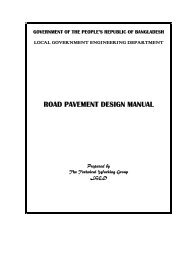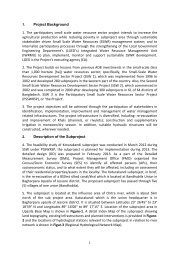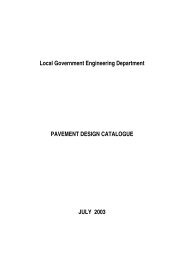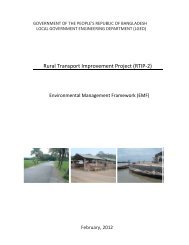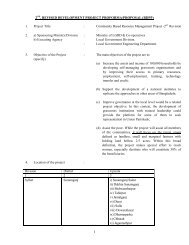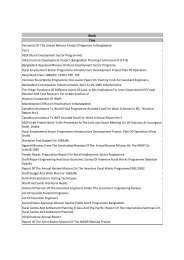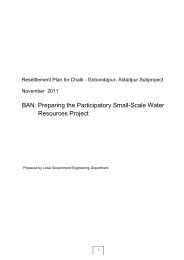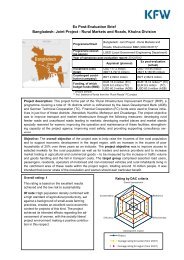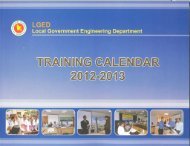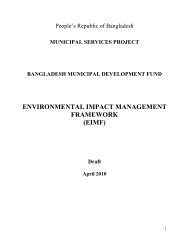PAD - LGED
PAD - LGED
PAD - LGED
You also want an ePaper? Increase the reach of your titles
YUMPU automatically turns print PDFs into web optimized ePapers that Google loves.
strengthen governance in the rural road sub-sector and prevent and mitigate corruption at the<br />
project level.<br />
4. The Bank’s strategy for improving governance in Bangladesh, laid out in its 2011-2014<br />
Country Assistance Strategy, focuses on developing accountability mechanisms in public sector<br />
operations, especially through increased transparency. The Bank seeks to align with Government<br />
priorities in developing the means of accountability, especially strengthening of public financial<br />
management, support for local government, use of information and communication technology<br />
(ICT) and the adoption of a Right to Information (RTI) regime. In particular, the Bank is<br />
working with the Government to improve budgeting practices among line agencies in<br />
conjunction with enhanced accountability mechanisms. It is working to increase the role and<br />
quality of oversight of public finances by the Parliamentary Accounts Committee, improve<br />
capacity of the Comptroller and Auditor General’s Office, and promote greater public<br />
understanding of public financial management to build more informed demand and ability to<br />
hold Government accountable. The Bank’s strategy also focuses on improving public service<br />
delivery, a key component which is fostering greater accountability to recipients of services<br />
including through a strengthened role for local government. The Bank supports the<br />
Government’s efforts to establish functioning RTI regime, including building capacity in all<br />
agencies to provide information more fully and efficiently. The Bank also continues to<br />
emphasize the importance of building demand for good governance among civil society. This, in<br />
turn, requires engaging with the civil society and monitoring the performance of the public<br />
sector.<br />
<strong>LGED</strong> and Good Governance Practices<br />
5. Worldwide, the transport sector is associated with governance risks, including fraud and<br />
corruption. Some of the key evidences of these risks include low competition in bidding<br />
processes, unsatisfactory quality of works, and large cost and time overruns. By their very<br />
essence, transport infrastructure projects also have direct impacts on local communities due to<br />
land acquisition and construction activities in inhabited areas, which require careful<br />
management.<br />
7. Following some incidences of inappropriate bidding practices in <strong>LGED</strong> as identified in<br />
post reviews as well as allegations of poor quality and unfinished road works, <strong>LGED</strong> and the<br />
Bank jointly carried out the ORA of <strong>LGED</strong> in 2009. The ORA assessed fiduciary and operational<br />
risks in <strong>LGED</strong>'s management of projects, assets and other resources, and in <strong>LGED</strong>’s oversight<br />
function. The study highlighted a gap between <strong>LGED</strong>’s advocacy of project management tools,<br />
systems and processes and weaknesses in planning, contract management and overall oversight<br />
of fiduciary activities, reporting back from field to HQ, and lack of monitoring. Although<br />
information and communication systems are relatively progressive in <strong>LGED</strong> compared to other<br />
government departments, the use of many different systems, lack of integration, unsustainable<br />
funding of personnel through donor-funded projects and inadequate internal controls make it<br />
difficult for <strong>LGED</strong> to gather and consolidate reliable information and do not facilitate reporting<br />
and control. <strong>LGED</strong> prepared a Fiduciary and Operational Risk Management Improvement Plan<br />
(FORMIP) that (i) prioritizes options which are realistic and available to effectively minimize<br />
(and where possible, eliminate) the major operational risks identified, and (ii) identifies options<br />
64



